Visit Changsha again
On April 23, 2023, I went on a business trip to Changsha, Hunan Province to attend an exchange meeting. Although it was cloudy and rainy, I reported to the venue where the meeting was held in the afternoon and took a short rest. I took a taxi to Yuelu Academy at around 2:30.

This trip to Changsha is actually a return visit to the old place after nearly 33 years of absence. The first time I went to Changsha, Hunan Province was in early June 1989 on a business trip from Fuzhou, Fujian Province to Yulin, Guangxi. When I stopped and transitioned in Zhuzhou, I went to Changsha, the capital of Hunan Province. I visited Yuelu Academy and Juzizhou Tau in Changsha. I also took Shao No. 1 train specially went to Shaoshan. In the summer of 1990, he traveled from Lushan, Jiangxi to Zhangjiajie, Hunan, and also stopped in Changsha. In the blink of an eye, more than 30 years have passed, Changsha has transformed from the ordinary capital city of central and southern provinces in memory to a food and tourism consumer city where Internet celebrities check in.

Yuelu Academy is located at the eastern foot of Yuelu Mountain on the west bank of the Xiangjiang River in Changsha City. It is one of the four famous academies in Chinese history. It was founded in the ninth year of Kaibao of the Northern Song Dynasty (976 AD). It was built by Zhu Dong, the prefect of Tanzhou, on the basis of running schools by monks and donated funds from the government. In the eighth year of Xiangfu of the Northern Song Dynasty (1015 AD), Emperor Zhenzong of Song Dynasty summoned Zhou Shi, the chief of the academy, and gave him a four-character gate title of "Yuelu Academy". Yuelu Academy has experienced many wars in history. It was destroyed seven times and built seven times. It went through the Song, Yuan, Ming and Qing dynasties. By the 29th year of Guangxu in the late Qing Dynasty (AD 1903), it was transformed into Hunan Higher Education Institute. In 1926, it was officially named Hunan University. In 1988, the Yuelu Academy Building Complex was approved by the State Council as the third batch of national key cultural relics protection units.

In my memory, for more than 30 years, the ancient trees of Yuelu Academy are towering into the sky, and the ancient buildings are elegant and solemn. Although there are some school buildings near the academy, the front of the academy is still relatively clear and open, but now it is surrounded by Hunan University and hidden in the depths of the school buildings. Walking into the campus of Hunan University, you will come to the front of Yuelu Academy and spend a 40-yuan ticket to visit the door.

The ancient building complex of Yuelu Academy is divided into five major architectural patterns: teaching, book collection, sacrifice, garden and memorial. The layout adopts the form of a courtyard with symmetrical axes and multiple in-depth.

The main buildings such as the head gate, the gate, the second gate, the lecture hall, and the Imperial Book Tower are concentrated on the central axis, and the lecture hall is arranged in the center of the central axis. Zhai houses, sacrificial temples, etc. are arranged on both sides. The courtyard with symmetrical axes and progressive layers not only creates a solemn, magical, and remote sense of depth and visual effect, but also reflects the social ethical relationship of Confucian culture with superior and orderly, different levels, and distinct primary and secondary. Most of the main existing buildings of Yuelu Academy are relics of the Qing Dynasty. In recent years, some buildings destroyed in the war have been rebuilt one after another.

The front door of the academy in front of you is obviously a new building built in previous years. The Yuelu Academy has gone through thousands of years and has endless songs. It is now a college affiliated to Hunan University. It is said that history and philosophy are taught here. It is appropriate to call the Yuelu Academy a "thousand-year-old institution".

Beyond the door is Hexi Terrace. This platform was originally built on the top of Yuelu Mountain by the prefect Sun Cun in the seventh year of Jiajing of the Ming Dynasty (AD 1528). Wang Shouren once wrote a poem: "Love hangs across the river and Yuelu Mountain for a long time. Thunderstorms come day and night. How can the breeze sweep away the mist and shake your clothes straight to the Hexi Terrace", and later gradually abandoned. In the 55th year of Qianlong of the Qing Dynasty (1790 AD), Luo Dian, the chief of Yuelu Academy, moved to build Hexi Terrace in front of the academy.

Crossing Hexi Terrace is the famous gate of Yuelu Academy.

This gate was rebuilt in the seventh year of Tongzhi of the Qing Dynasty (1868 AD). It adopts a southern general gate structure. It was built on twelve steps, with five hard mountains, three mountain screens and walls. A pair of square columns are erected in front, white walls and blue tiles are placed. Dripping water at the head of the glaze ditch and empty flowers on the roof. The Fangliang is painted with wandering dragons playing Tai Chi, and mixed with grass and cloud patterns. The overall style is generous.

The "Yuelu Academy" on the front of the door is written by Emperor Zhenzong of Song Dynasty. There are couplets hanging on both sides of the gate,"Only Chu has talents, but it is prosperous in this place." The first couplet is from "Zuo Zhuan·The Twenty-sixth Year of Xianggong", and the second couplet is from "The Analects of Confucius·Taibo". It originates from classics and connects with concern. The forehead and couplet of the gate of Yuelu Academy reveal the rich heritage and bearing of the emergence of talents from thousands of years of academic institutions.
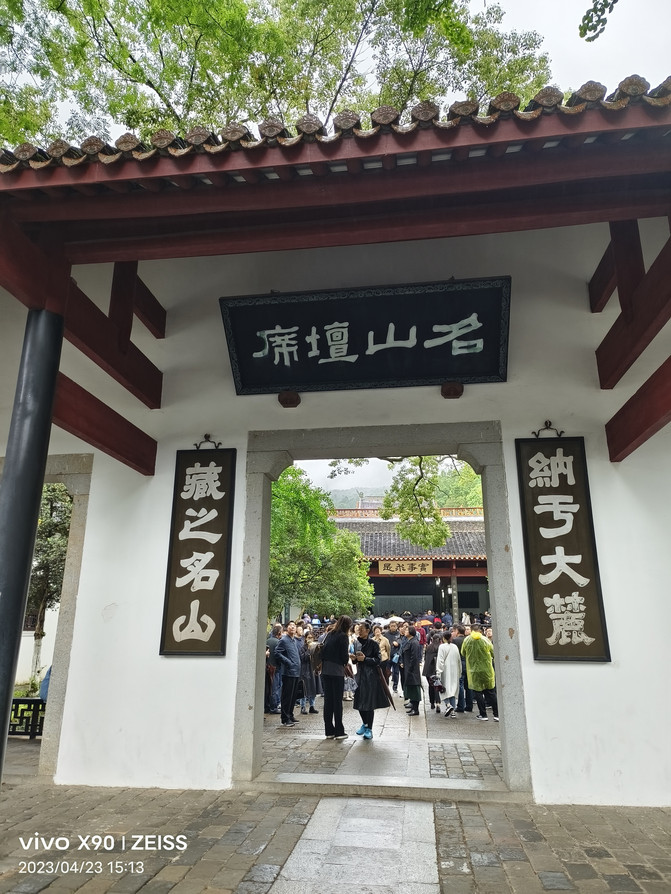
The second gate of Yuelu Academy was rebuilt in 1984. I should have visited Yuelu Academy for more than 30 years. However, I have no impression of it, and this time I have a new understanding. Just above the forehead of the door hangs a plaque of "Famous Mountain Altar Seats", which is composed of the words of He Shaoji, a famous Hunan calligrapher in the Qing Dynasty. There is a couplet on both sides,"Covered at the Great Lu; Famous Mountain in Tibet". The first couplet is from "Shang Shu·Shun Dian", and the second couplet is from "Shi Ji·Tai Shi Gong's Preface", which means that the Yuelu Academy is hidden by vast forests and hidden in the Yuelu Mountains with vast land and abundant resources. The author of the couplet was Cheng Songwan, the supervisor of Hunan Higher School in the late Qing Dynasty.
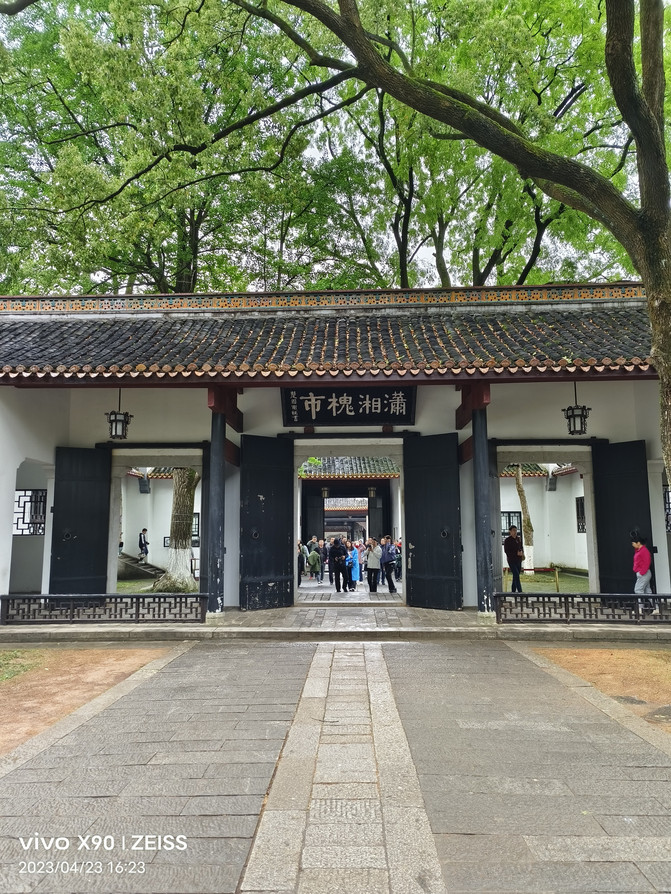
On the back of the second gate, there is a plaque "Xiaoxiang Huaishi" that was originally written by Cheng Songwan, the dean of the Qing Dynasty, but was destroyed during the Anti-Japanese War. Later, Chu Tunan, former vice chairman of the Standing Committee of the National People's Congress and chairman of the Central Committee of the Democratic League, wrote a new plaque. "Xiaoxiang Huaishi" means that Yuelu Academy is a place where Hunan literati and scholars gather. It is extended to the prosperity of talents in Yuelu Academy, just like the prosperity of Huaishi in Chang 'an Taixue in the Han Dynasty.

After the second gate, the Yuelu Academy Lecture Hall is deep in the courtyard ahead. There is a plaque of "Seeking Truth from Facts" hanging in front of the eaves of the lecture hall. It was written by Bin Bucheng, the principal of Hunan Public Industrial College in the early Republic of China."Seeking Truth from Facts" originated from "Hanshu: The Biography of King Liu De in Hejian". Bin Bucheng used it as the school motto when Yuelu Academy was transformed into Hunan Engineering College. The school motto was to educate students to advocate science and pursue truth. This had a great impact on Mao Zedong, who lived in Yuelu Academy at that time, and later became a core part of Mao Zedong Thought.

The Yuelu Academy Lecture Hall is located in the center of the Academy. It is the important teaching place of Yuelu Academy and a place for holding major activities. It is also the core part of the Academy. Since the establishment of Yuelu Academy in the ninth year of Kaibao in the Northern Song Dynasty (976 AD), there have been "five lecture rooms" in the lecture hall. When I visited Yuelu Academy more than 30 years ago, what impressed me most was this lecture hall, especially the stone tablets with the four characters "Loyalty, Filial Piety, Integrity, and Integrity" that are rumored to be written by Zhu Xi in calligraphy on the inner wall of the lecture hall.
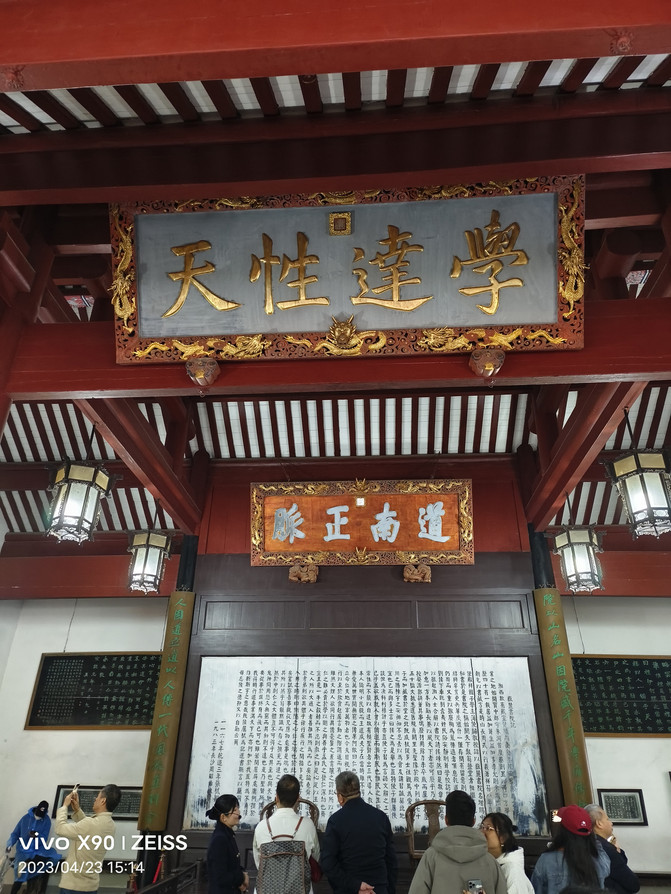
Two gilded wooden plaques are hung in the center of the hall: one is "Learning to Achieve Nature", which was given by Emperor Kangxi in the spring of the 26th year of Kangxi of the Qing Dynasty (1687 AD). It is intended to encourage Yuelu Academy to publicize Neo-Confucianism and strengthen self-cultivation. The original plaque was destroyed. It was reproduced in 1983 based on the old photo Kangxi handwriting. The second is "Daonan Zhengmai", which was awarded by Emperor Qianlong in the eighth year of Qianlong of the Qing Dynasty (AD 1743) to praise the Yuelu Academy for spreading the Neo-Confucianism of Zhu (Xi) and Zhang (Xi), demonstrating the Yuelu Academy's position in the history of the dissemination of Neo-Confucianism in China. This amount is the original.

The front wall of the lecture hall below the plaque is engraved with the "Notes of Yuelu Academy". It was written by Zhang Wei, bishop of the Academy and a Neo-Confucian scholar in the second year of Qiandao in the Southern Song Dynasty (AD 1166). It is the basic outline for Yuelu Academy to cultivate talents and has a major impact on academy education.

Two lecture chairs were placed on the podium in front of the screen wall of the lecture hall, implying the famous Zhu Zhang lecture at the Yuelu Academy in the third year of Qiandao in the Southern Song Dynasty (AD 1167). That year, the Neo-Confucianism scholars Zhang Yi and Zhu Xi held a "lecture" at the Yuelu Academy, which was the first of its kind in Chinese academies.
In the first year of Qiandao in the Southern Song Dynasty (AD 1165), the famous Neo-Confucian scholar Zhang Wei was bishop of Yuelu. In the autumn of the third year of Qiandao (1167 AD), Zhu Xi, a Neo-Confucian scholar of the Southern Song Dynasty, accompanied by his disciple Lin Yongzhong, traveled 2,000 miles from Chong 'an, Fujian Province to visit Yuelu Academy on the Xiangjiang River in Tanzhou (now Changsha, Hunan Province). He exchanged views with Zhang Wei, the bishop of Yuelu Academy. One of them was a representative of Fujian Studies and the other was a representative of Huxiang School. The debate lasted for three days and three nights, attracting scholars from all over the world to gather and listen in this mountain courtyard on the west bank of the Xiangjiang River. The occasion was unprecedented."Scholars who come here cannot be tolerated, and the water in the horse drinking pond dries up." History says that "Zhu Zhang will speak." In the end, Zhu and Zhang reached an agreement in many aspects. Zhang made adjustments to the development direction of the Huxiang School. Zhu Xi's "Zhonghe Old Theory" was also decisively transformed into "Zhonghe New Theory". This lecture was the first time in the history of Chinese academies. Free exchanges, dialogue and mutual questioning between different schools promoted the development of Neo-Confucianism in the Song Dynasty and ancient Chinese philosophy. Eight years later, there was a meeting in Ehu between Zhu Xi of Bailudong Academy in Jiangxi Province and Lu Jiuyuan of Yanshan Ehu Academy, which became a common phenomenon in the Ming Dynasty.
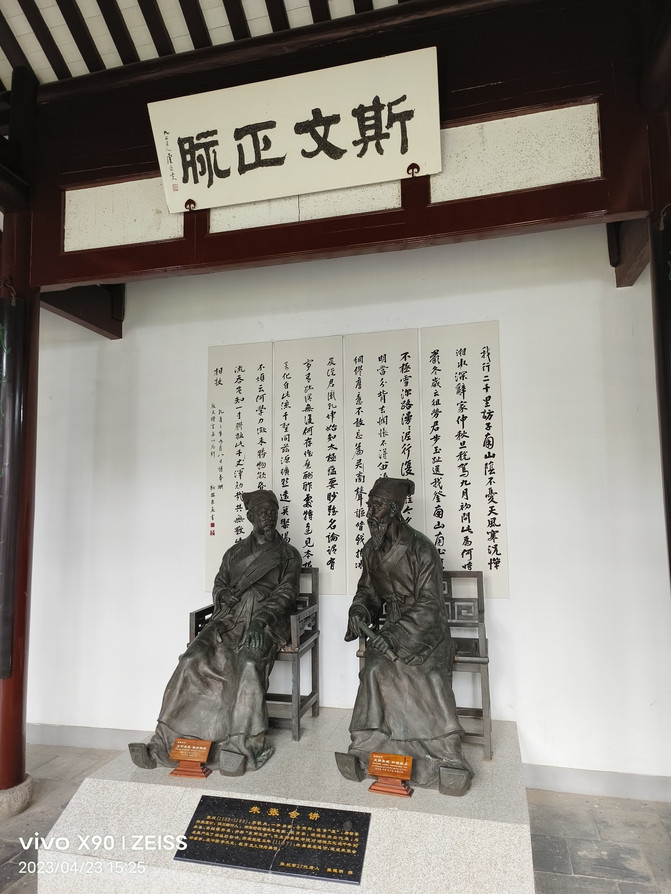
Zhu Zhanghui's speech also demonstrated the status of the Huxiang School based on the Yuelu Academy, which made the Yuelu Academy sing endlessly throughout the dynasties. A large number of scholars from Hunan and surrounding provinces came to the Yuelu Academy to study, study scriptures and study principles. Some scholars even "hate not being able to graduate in Huxiang." Wu Cheng, an agent scholar of the Yuan Dynasty, wrote in "Notes on the Reconstruction of Yuelu Academy","From then on, Yuelu is Yuelu, not the Yuelu before!"
In the twenty-seventh year of Zhu Zhang's lecture and 14 years after Zhang Wei's death, Zhu Xi served as Hunan's appeasement envoy in the fifth year of Shaoxi of the Southern Song Dynasty (AD 1194). He once again came to the Yuelu Academy in Tanzhou to give lectures, reorganized the Yuelu Academy, promulgated the "Zhu Zi Academy Doctrine", and built the academy "in a place where the rules are new." After Zhu Xi's renovation, Yuelu Academy once again entered a prosperous period. In the second year of Zhengde in the Ming Dynasty (1507 AD), Wang Shouren, a master of the generation of Mind Studies of Yangming, and his disciples gave lectures at Yuelu Academy, bringing Yuelu Academy to another period of academic prosperity.
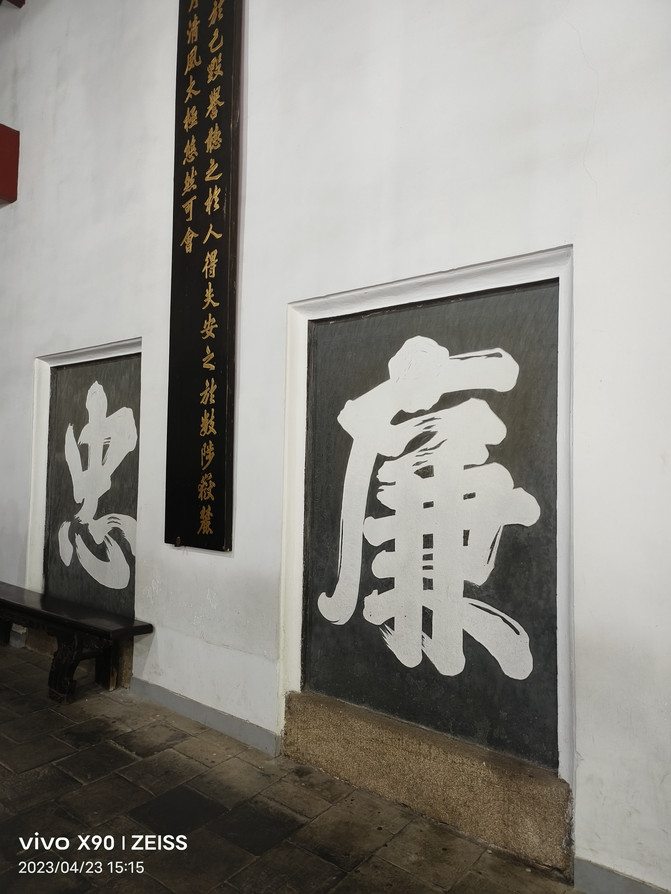

The stone tablets with the four characters "loyalty, filial piety, integrity and integrity" embedded on the two walls of the lecture hall are said to be written by Zhu Xi and were published by Ouyang Houjun, the chief of Yuelu Academy in the seventh year of Daoguang in the Qing Dynasty (1827 AD).


There are four stone tablets with the characters "Zheng, Qi, Yan and Su" in corridors on both sides of the lecture hall. They are inscriptions for Ouyang Zhenghuan, the chief of Yuelu Academy during the Qianlong period of the Qing Dynasty, and Ouyang Hou, the chief of Yuelu Academy during the Daoguang period. The two groups of large-character stele inscriptions "loyalty, filial piety, integrity, and integrity" and "rectification, Qi, strictness, and Su" are rare in the history of ancient Chinese calligraphy stele inscriptions.


On both sides of the lecture hall are the north and south two houses, which are the teaching house and the semi-learning house. They are both former residences for teachers and students. In the past, students spent a lot of their activity time here to study themselves. Yuelu Academy has a long history of building Zhai houses. Since the ninth year of Kaibao of the Northern Song Dynasty (976 AD), 52 Zhai houses have been built. The existing buildings were rebuilt when the school was renovated in the 29th year of Guangxu of the Qing Dynasty (1903 AD). They were originally named Teaching Zhai and Banxue Zhai to meet the needs of teaching and office. The name of "Teaching Zhai" comes from "Book of Rites·Xueji", and the name of "Banxuezhai" comes from "Shang Shu·Shuo Mingxia". I remember when I visited Yuelu Academy more than 30 years ago, I saw a small house in "Banxuezhai" marked as the residence where Mao Zedong lived in Yuelu Academy. Today, there is no such sign. Nanbei Erzhai seems to have become a historical showroom of the academy and a tourist goods shop.
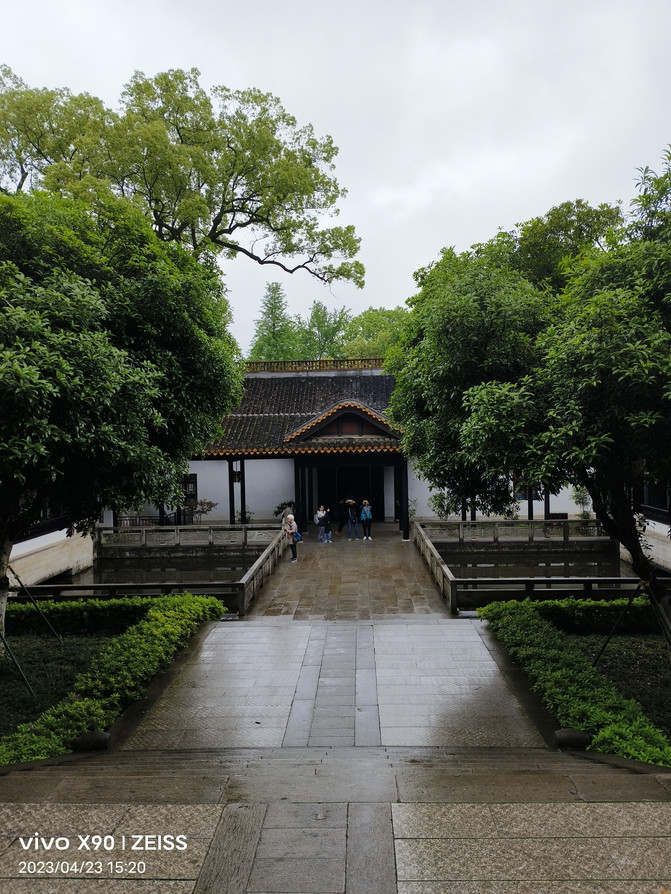
Go through the lecture hall and enter the back courtyard.


There are two square ponds in the courtyard. There is a Jiquan Pavilion on the north side of the pond and a Xianglan Pavilion on the south side.

At the end of the courtyard is the Yuelu Academy Library. The library building is the main place that embodies the three major functions of teaching, collecting books, and offering sacrifices to ancient Chinese academies. The Yuelu Academy was built behind the lecture hall since its establishment. After Emperor Zhenzong of the Song Dynasty gave it a book, it was renamed the "Imperial Book Pavilion". It was also called the "Zunjing Pavilion" in the Yuan and Ming Dynasties. Its location changed. In the 26th year of Kangxi of the Qing Dynasty (1687 AD), Governor Ding Sikong requested books such as the Thirteen Classics and Twenty-one History from the court to build the Imperial Book Tower on this site. In the middle of the Qing Dynasty, Yuelu Academy Yueshulou had developed into a relatively large private library in China, with a collection of 14130 volumes. At present, the Imperial Book Building of Yuelu Academy seems to be the Ancient Books Library of Hunan University. It is said that the collection of books has exceeded 50,000 volumes. Large-scale reference books such as "Siku Quan Shu","Continuation of Interpretation of Siku Quan Shu","Sibu Series","Sibu Bei Yao","Integration of Ancient and Modern Books", etc. are all collected.

There are a large number of steles embedded in the Imperial Book Tower and the complex corridor. Among them, the stele of Zhu Xi's poem "Two Poems in Reward, Respect, and Say Goodbye" engraved in the "Zhu Xi Poetry Stele" was carved by Wu Dacheng, governor during the Guangxu period of the Qing Dynasty. In September of the third year of Qiandao in the Southern Song Dynasty (1167 AD), after Zhu Xi and Zhang Xi gave lectures at the Yuelu Academy, Zhu Xi still gave lectures and discussed Taoism at the Yuelu and Chengnan Academies chaired by Zhang Xi. He sailed through Juzizhou and traveled between the state city and Yuelu. It lasted for two months. Today, there are still Zhu Zhangdu monuments in Juzizhou. In November, the two of them traveled to Hengshan Mountain in Nanyue for seven days, braving snow and climbing mountains. They traveled 200 miles and sang with each other to form a collection of "Nanyue Singing Collection" in Zhuzhou. Zhang Hui wrote a poem "Send Brother to Yuan Zun" and presented it to Zhu Xi, who wrote a poem "Send Yuan Zun Brother" to Zhu Xi. Zhu Xi responded with this poem. I once saw the temple of the two sages dedicated to Zhu Xi and Zhang Wei in Fangguang Temple in Hengshan. This time, I saw the monument of Zhu Xi's poetry in Yuelu Academy. I saw the scene of two great scholars of the Southern Song Dynasty more than 850 years ago loving each other and traveling together in mountains and rivers.


The special temple courtyard on the north side of the main building complex on the center axis of Yuelu Academy, dedicated to Zhou Lianxi, Ercheng, Zhu Xi, Zhang Yi, Wang Chuanshan, Luo Dian, etc. seems to have been rebuilt a few years ago. I don't seem to have seen it before.
For more than 30 years, I have been accompanying me to visit Yuelu Academy, mainly to see the main building of the academy, and I have never stopped anywhere else. This time, I accidentally discovered the Confucian Temple across the courtyard on the north side of the central axis of Yuelu Academy. It was a surprise.
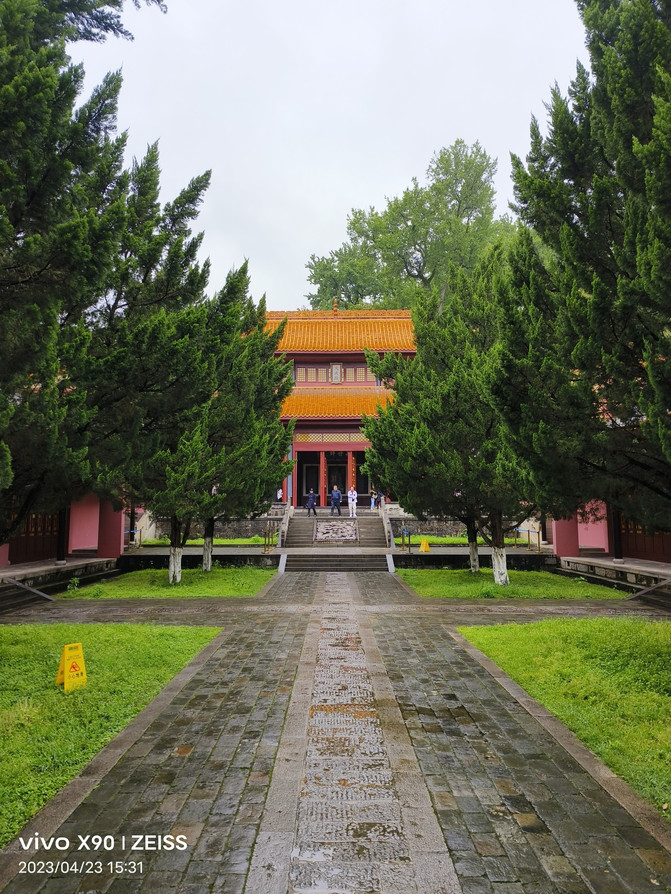
The Confucian Temple (Confucian Temple) of Yuelu Academy in Changsha is said to be the largest and highest architectural standard academy Confucian Temple in the country. It was founded in the 9th year of Kaibao in the Northern Song Dynasty (976 AD). It was built on the basis of running schools by monks in the late Tang Dynasty. In the second year of Xianping of the Song Dynasty (999 AD), the Temple of Rites was expanded to "shape the portraits of ten sages of the ancestors and write about seventy-two sages." For the purpose of worshipping Confucius, the function of the Temple of Confucius was established, and the Yuelu Academy has since formed the regulation of "lectures, books collection, and sacrifices."


The two stone archways in the Confucian Temple of Yuelu Academy should be old objects. One stone archway has the front with the inscription "Dao Crown Ancient and Modern" and the back with the inscription "Xian Guan".

Another stone archway has a front area with "Virtue Tiandi" and a back area with "Sanctuary".
Walk through the "Daoguan Ancient and Modern" stone archway and enter the Confucian Temple.

There is a statue of Confucius in the courtyard that was created several years ago.

Along the way, you will find the Confucian Temple complex with red walls and yellow tiles in front of you. Most of the original buildings of the Confucian Temple of Yuelu Academy were destroyed by Japanese invaders in 1937, and were later rebuilt. After the 1980s, Dacheng Hall, Dacheng Gate and two verandas were successively restored, and Chongsheng Temple and Minglun Hall were rebuilt. In August 2013, a 200-year-old ancient maple tree fell due to heavy rain on Yuelu Mountain, damaging Dacheng Hall and causing the death of a female tourist. The current Dacheng Hall was rebuilt after the heavy rain in 2013. I have little interest in the newly built antique buildings in recent years, so I rushed past Dacheng Gate and Dacheng Hall without stopping.

A plaque of "Ten Thousand Shi Shi Biao" hangs in the Dacheng Hall. The woodcut statue of Confucius enshrined in the hall is on both sides of the "Praise and Preface to Confucius, the First Teacher of Confucius" made by Emperor Kangxi of the Qing Dynasty. The "Preface" is on the right and the "Praise" is on the left. Hanging on the gables on both sides of the Dacheng Hall are the four sages Yan Hui, Kong Ji, Meng Ke and Zeng Shen who enjoyed the Confucian Temple.

The last main hall of the Confucian Temple is the Chongsheng Temple, which is a tourist-free classroom at Hunan University. There are several students dressed in ancient costumes there. There are one or two places in the Yuelu Academy that are inaccessible to tourists, such as Quzi Temple, which is where teachers and students of Hunan University have classes. This is the reason why the Yuelu Academy has been singing for thousands of years.





On the south side of the central axis of Yuelu Academy is a garden with winding paths leading to the secluded scenery, flowing streams and wine cups, and lush bamboo and wood. It seems like there are no tourists coming in, but it is a good place for research and meditation.

The Lushan Temple stele pavilion on the south side of the garden was my first visit to Yuelu Academy. This stele pavilion was built by Qian Shu, the prefect of the Ming Dynasty (1469 AD) and rebuilt in 1962.


The "Lushan Temple Stele" in the pavilion is one of the most influential existing steles in China. It was written, written and engraved by the famous calligrapher Li Yong in the 18th year of Kaiyuan in the Tang Dynasty (730 AD). It is known as the "Sanjue Stele" because of its excellent writing, calligraphy and carving.

Climbing up the mountain along the Yuelu Academy corridor, leaving the west gate of the academy is the Qingfeng Gorge of Yuelu Mountain.

There is an Aiwan Pavilion deep in the canyon. This pavilion is also known as the four famous pavilions in China, along with the Zuiweng Pavilion in Chuzhou, Anhui (built in 1046), the Lake Center Pavilion in Hangzhou, Zhejiang (built in 1552), and the Taoran Pavilion in Beijing (built in 1695).

Aiwan Pavilion was built in the 57th year of Qianlong of the Qing Dynasty (AD 1792). It was founded by Luo Dian, the chief of Yuelu Academy in the Qing Dynasty. It was originally named Hongye Pavilion. Later, it was renamed Aiwan Pavilion by Bi Yuan, the governor of Huguang, according to Du Mu of the Tang Dynasty,"Parking and sitting in Love Maple Forest at night, frost leaves are red than February flowers". After many major repairs, the current pattern was gradually formed.
Aiwanting was destroyed during the Anti-Japanese War, rebuilt in 1952, and overhauled in 1987. Aiwan Pavilion is simple and elegant. The pavilion has gold pillars inside, round wood and red lacquer, and four outer eaves pillars. It is made of a whole square granite. It retains more of the architectural styles of Qing Dynasty pavilions and pavilions. The roof of the pavilion has double eaves and four drapes, with a sharp treasure roof, and the four wing corners are far and high, covered with green glazed tiles.
Aiwan Pavilion sits from west to east, surrounded by mountains on three sides, and is open to the east, with lush purple and green onions and endless flowing springs. There is a pond in front of the pavilion, and peach willows are lined. The pavilion is surrounded by maple forests, and the mountains are covered with red leaves in late autumn. There is no need to talk about the scenic spots.

Aiwan Pavilion is a stop, not only because of its scenery, but also because of Mao Zedong's fame. Mao Zedong studied at the First Normal School in his youth. He often met with Cai Hesen and other fellow friends at Aiwanting to talk about the current situation and explore the truth. On the front of Aiwan Pavilion, the vermil-gold plaque "Aiwan Pavilion" inscribed by Mao Zedong is the finishing touch of Aiwan Pavilion. It was written by Li Da, then President of Hunan University, who asked Chairman Mao Zedong to write a special letter.

There is a horizontal plaque in the pavilion engraved with the words "Qinyuanchun·Changsha" written by Mao Zedong. The pen moves like a dragon and snake, making the ancient pavilion shine brightly.
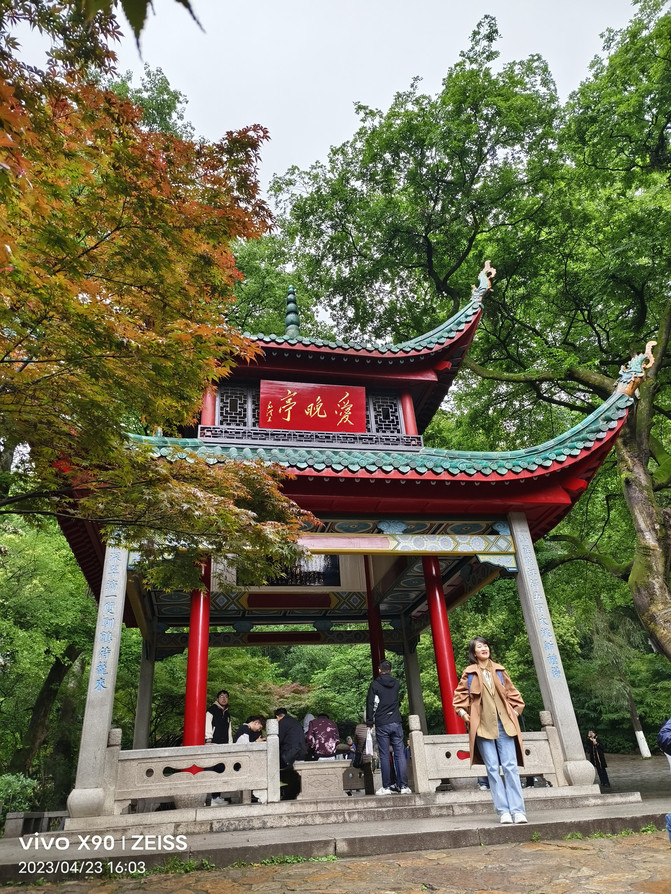
Perhaps it was because of Sunday that the Aiwan Pavilion was crowded with tourists. It was not easy for me to find a moment when there were few tourists to take pictures. This situation was also true in Yuelu Academy, which shows that the Yuelu Academy and Aiwan Pavilion are famous.
After leaving Aiwan Pavilion, spend another 40 yuan ticket to return to Yuelu Academy, and then leave Yuelu Academy after lingering again. There are actually many historical relics and scenic spots in Yuelu Mountain. Unfortunately, due to time constraints, they cannot be visited and can only be left for a later date.
After leaving Hunan University, I saw an antique building called the "Inferiority Pavilion" on the roadside.
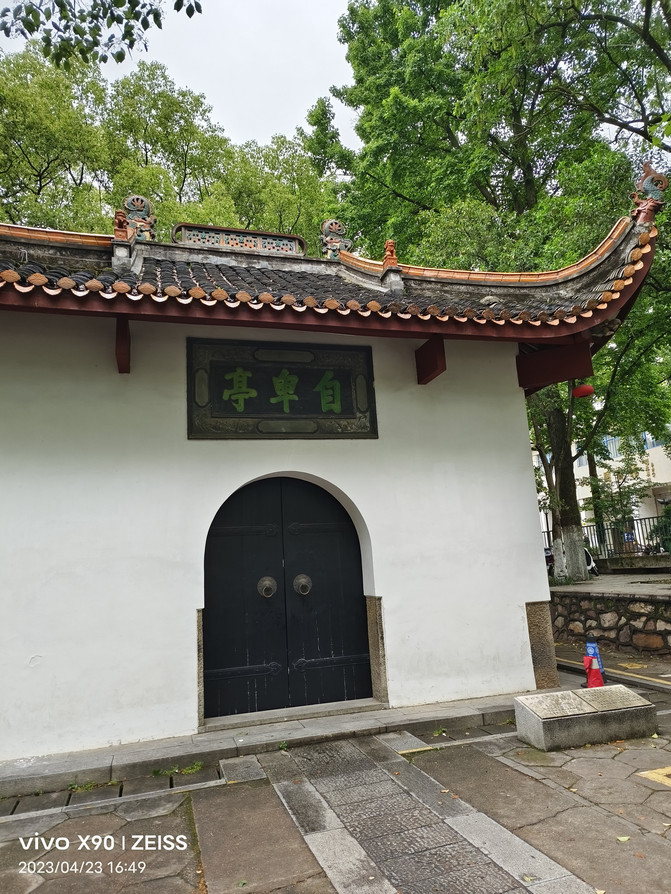
This pavilion is about 200 meters east of the academy. It was built by Zhao Ning, the governor of Changsha, on the road leading to Yuelu Academy in the 27th year of Kangxi of the Qing Dynasty (AD 1688) for pedestrians to rest. It was originally the entrance to Yuelu Academy. The stone road along the way leads directly to the gate of the academy. The existing building was built in the 11th year of Xianfeng of the Qing Dynasty (AD 1861). The three words "Inferiority Pavilion" are the inscriptions of the mountains and carriages of Yuelu Academy in the Qing Dynasty. The pavilion contains inscriptions such as "The Story of Inferiority Pavilion". Unfortunately, the pavilion door was closed and I couldn't enter and have a look. The name of the Inferior Pavilion comes from the "Doctrine of the Doctrine of the Inferior of the Doctrine of the It means that moral cultivation and academic breaks must be looked close, starting from a low point, step by step, and persevere. Time has changed, and today the meaning of the word "inferiority" is no longer in the context of "The Doctrine of the Mean".
It was getting late, and I took the subway at Hunan University Subway Station to rush to Juzizhou in the misty rain. I remember that more than 30 years ago, when I arrived at Juzizhou, I took a bus through the Xiangjiang River Juzizhou Bridge to Juzizhou in the middle of the bridge, and then got off the bridge and entered the continent. Now I can just get out directly from the subway Juzizhou Station, which is very convenient.

Juzizhou is located in the center of the Xiangjiang River in Yuelu District, Changsha City, Hunan Province. It is the largest sandbank among the many alluvial sandbanks in the lower reaches of the Xiangjiang River and is known as "China's No. 1 continent." From south to north, it traverses the center of the river, west to Yuelu Mountain, and east to Changsha City. It is surrounded by water on all sides and stretches for more than ten miles. The narrow part is about 40 meters across and the wide part is about 140 meters across. The shape is a long island. One of the eight scenic spots in ancient Xiaoxiang,"River Sky and Sunset Snow", is located on Juzizhou. Xiao Dajing's "Xiao Xia Shi" of the Song Dynasty praised Juzhou as "Little Penglai". As far back as the Tang Dynasty, Orange Island was rich in southern oranges and was exported to Jianghan and other places. At the end of the Tang Dynasty, Li Ci "got flowers in autumn, on Xiaoxiang night, and the beautiful scenery of Orange Island is like a screen painting. In the blue smoke and under the bright moon, the small boat was beginning to stop. The water is the hometown, the tents are suitable, and fish soup and rice are eaten frequently. The poem "Wine fills the cup, books fills the shelf, fame and fortune does not worry about" depicts the river scenery of Juzhou 1200 years ago. Du Fu also wrote the poem "Taoyuan people change their systems, but the farmland of Juzhou is still rich."
Walking south from the subway station, looking around, the Xiangjiang River is divided into two by Juzizhou. On the west side, the Xiangjiang River is separated by the lush Yuelu Mountain and the university town at the foot of the mountain; on the east, there is the Changsha Urban area with many high-rise buildings, forming a unique landscape of "one green mountain on one side and one city on the other" on both sides of the Xiangjiang River.


Orange Island stretches from north to south, with green spaces, inner lakes, orange gardens, flower gardens, etc., as well as many dining places. Walking during holidays, Orange Island is a good place to relax.

Braving the occasional drizzle, we headed south to Juzizhou Head. Along the way, I passed through the former Changsha Customs Office, Mei Foo Yanghang, Tang Shengzhi Mansion and other sites that witnessed the historical winds and frost of Changsha after the opening of the port. These were all sites I had not noticed or exactly unknown when I was in Juzizhou.

Juzi Island is imbued with the strong historical heritage of Huxiang culture. Zhu Xi and Zhang Shi traveled between Yuelu Academy and Chengnan Academy to teach and cross the river, explaining the grand occasion of Huxiang children's schooling more than 800 years ago. At the end of the Qing Dynasty, it is said that Zeng Guofan once trained the Hunan Army Navy in Juzizhou. Of course, what should be mentioned is that Mao Zedong stood at the head of Juzizhou in 1925 and looked north of the Xiangjiang River."I asked who is in charge of the ups and downs on the vast land?" Tianwen. Today, the poem stele engraved with Mao Zedong's "Qinyuanchun·Changsha" has become a scenery of Juzizhou. Because of Mao Zedong, the head of Juzizhou has become an indispensable tourist attraction in Changsha.

In Mao Zedong's youth, when he was studying at Hunan No. 1 Normal University, he would often go to the tip of the continent to beat the waves and hit the water, point out the mountains and rivers, and inspire writing. After the founding of the People's Republic of China, he returned to Hunan several times and visited Juzizhou seven times. He also swam in the Xiangjiang River near Juzizhou many times.




Arriving at the head of Orange Island, there is a sculpture of young Mao Zedong with a total height of 32 meters, a length of 83 meters and a width of 41 meters. This is a must-stop place for tourists when visiting Juzi Island in recent years.

Continue moving forward and come to the end of Juzi Island. Looking north of the Xiangjiang River, it is misty and rainy.



Looking back on both sides of the Xiangjiang River, the Yuelu Mountain area on the west bank is a little quieter, while the Main City of Changsha on the east bank of the Xiangjiang River is brightly lit and the city is prosperous.


It was already dark, and I left the head of Orange Island and returned.

On the way, I drank a cup of Zhixiao tea recommended by the store in Juzizhou to relieve my fatigue and rested, and ended my revisiting Changsha with the aftertaste of tea and Zhixiang.
Previous Article:Two days and one night, her date in Changsha when she was single
Next Article:Changsha, a happy city!
